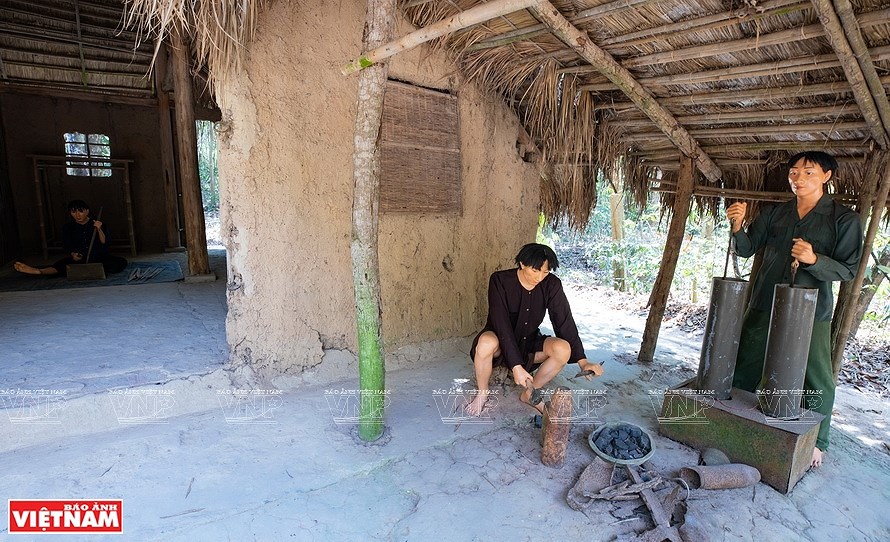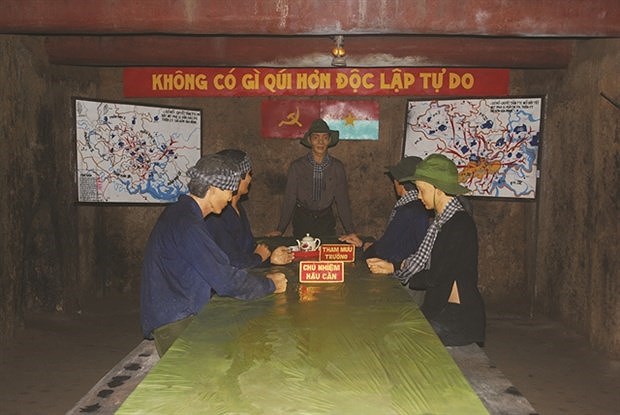Cu Chi Tunnels, a popular destination for both domestic and foreign tourists thanks to its unique historical and architectural values, may soon join UNESCO’s list of world heritage.
 Apart from the tunnels as a spotlight, the area now features a site replicating a small village in the liberated Cu Chi zone during the 1960-1975 period. (Photo: VNA)
Apart from the tunnels as a spotlight, the area now features a site replicating a small village in the liberated Cu Chi zone during the 1960-1975 period. (Photo: VNA) Cu Chi Tunnels, a popular
destination for both domestic and foreign tourists thanks to its unique
historical and architectural values, may soon join UNESCO’s list of world
heritage.
The People’s Committee of Ho Chi Minh City is
working on a dossier seeking UNESCO’s recognition for the tunnels.
Located in Tan Phu Trung and Phuoc Vinh An communes
in Cu Chi district, about 70km from downtown HCM City, the tunnels were built
by local residents and soldiers using simple tools from 1946 to 1968 as
shelters from US and Sai Gon troops during the war.
Initially, they dug only short sections with simple
structure to hide documents, weapons and resistance members. The tunnels were gradually
connected and extended into a system which by 1965 had a combined length of about
200km of underground trenches arranged in three floors. The deepest floor is
about 8-12 metres under the ground.
The tunnel system runs in a zig-zag shape underground,
and the main route branches out in multiple directions that connect in some
areas, depending on the terrain.
 The Cu Chi tunnels were the location of several military campaigns during the war. (Photo courtesy of Cu Chi Tunnels)
The Cu Chi tunnels were the location of several military campaigns during the war. (Photo courtesy of Cu Chi Tunnels)
Many exits open to the Sai Gon River so that in
emergencies residents in the tunnels could escape by river route to Ben Cat
resistance base in Binh Duong province.
The tunnel system is bulletproof and can withstand
the weight of tanks and armoured vehicles.
To complete the construction, dozens of soldiers and
residents braved the bombardment of the enemy and worked round the clock dig
and remove a huge amount of soil and rock in secrecy.
During his trip to the Cu Chi Tunnels in 1995, Cuban
Minister of Culture Armando Hart Davalos paised the courage and honour of
locals, as well as the rich culture of Vietnam, and described the tunnels as a
sacred site and great legend.
The system has significantly contributed to the
Vietnam’s major victories such as the 1968 Spring Mau Than General Offensive
and Uprising, and the Great 1975 Spring Victory.
After 1975, the tunnels have been preserved and upgraded
to become a revolutionary historical relic site, and is opened to tourists.
According to the management board of the Cu Chi
Tunnels, the relic site has welcomed about 1.5 million visitors each year,
including foreign high-ranking leaders and military officers.
Apart from the tunnels as a spotlight, the area now
features a site replicating a small village in the liberated Cu Chi zone during
the 1960-1975 period, along with a corner displaying weapons.
Tourists will also have a chance to experience farming
activities and taste special dishes in Cu Chi, notably “khoai mi” (cassava) that
was a main dish of locals during the wartime./.